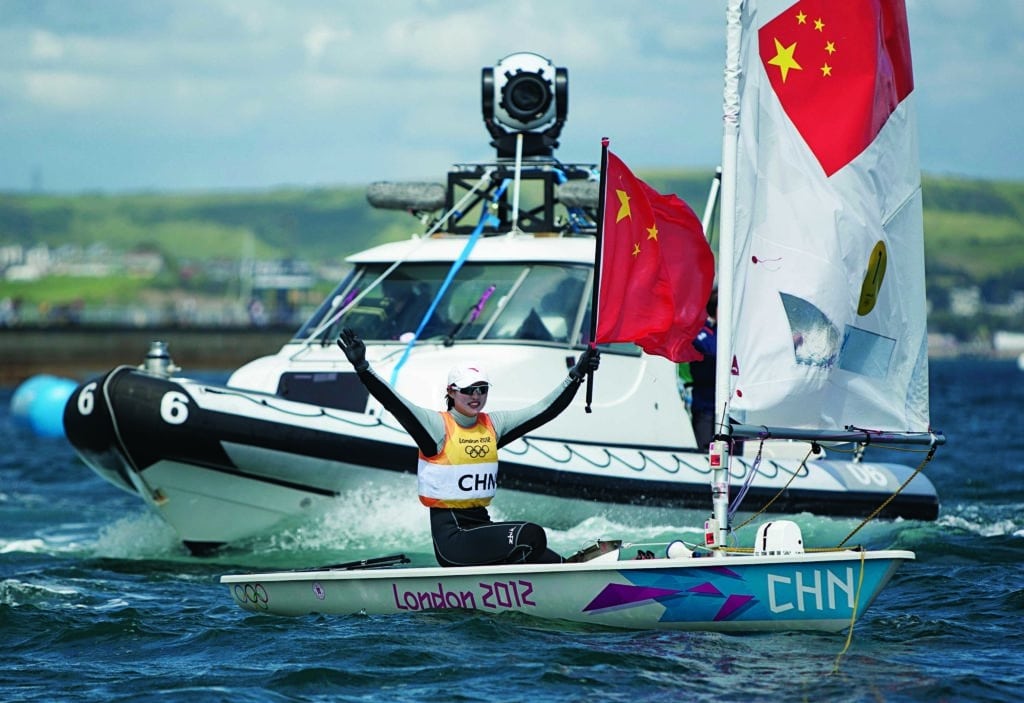
Lijia Xu (CHN) who won Gold the Medal today, 06.08.12, in the Medal Race Women’s One Person Dinghy (Laser Radial) event in The London 2012 Olympic Sailing Competition.
Chase boats mounted with giant globe-shaped cameras motor up the course alongside the Olympic fleet. These Cineflex cameras, worth a half-million dollars each and operated by a specially trained cameraman, provide a better-than-front-row view of the action, beaming footage to a broadcast center on the shore of the Marina da Gloria. There, a producer and director toggle between a dozen screens to find the preferred shot. They select the camera angle, and the live video feed beams across the globe: to NBC in the United States, Sky TV in New Zealand, Canal+ in France, and many others. The entire process takes less than 10 seconds, but the value of those seconds is immeasurable, especially for the 2016 Olympic Games.
“This is incredibly exciting for sailing because we’ll be racing at prime TV times in most of the world,” says Daniel Smith, World Sailing’s communications manager. “It’s the perfect opportunity for sailing to showcase itself, and we’ve been working tirelessly to make sure everything is in place.”
Racing will happen between 1 p.m. and 5 p.m. local time. With most other competitions scheduled for later in the day, in cooler temperatures, there’s less competition for broadcast attention.
Two of the seven racecourses, Pao de Acucar and Escola Naval, will have live video. The fleets will rotate through these courses during the regatta (see chart). Live feeds will include aerial shots and footage from shore cameras, mark cameras and onboard cameras.
Moments after it’s captured, the video is put on a world feed, where broadcasters can choose what to run and add their own commentary. Gary Jobson, who has been involved in the broadcast of every Olympic regatta since 1988, will once again lead the broadcast for NBC and its affiliates. “I have a strong sense of what people like and don’t like while doing these broadcasts,” he says. Jobson pictures himself in the boats, explaining what he himself would do to move up or maintain his position if he were sailing. “I want to keep sailing from being too clinical,” he says. “It will be a combination of play-by-play, Olympic history, tactics, and the emotional aspects as well.”
For those who don’t have access to the live stream, there will be live 2-D and 3-D tracking and results on the World Sailing site (www.sailing.org).Smith is most excited about the Sailviewer 3D app, test-driven during this quad’s World Cup events. “As the data comes pouring in, you can follow the race as it happens,” says Smith. The app is available at sailing.org, or through the Apple Store and Google Play Store.
Despite the development of the app, the live-streaming-capable equipment and tracking, the most challenging part of World Sailing’s mission is to ensure broadcasters understand how to cover sailing. “It’s frustrating if you’re a sailing fan and your broadcaster chooses to not run the coverage,” says Smith. “We’ve been working hard over this quad to ensure the broadcasters are not only aware of what sailing is but how the sport works.”Additionally, the sailing racecourses are set amid the most iconic Rio landscapes. The Pao de Acucar course, where the medal races will run, is below Sugarloaf Mountain and off Flamengo Beach, creating opportunities for sailing to be featured in panning shots of Rio. This luck of the draw could give sailing an opportunity to vault itself into and solidify its place in the spotlight.









